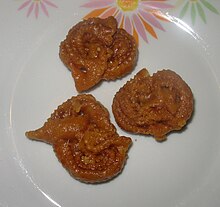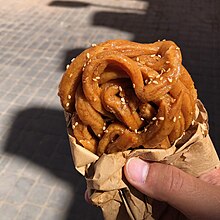 | |
| Type | Dessert |
|---|---|
| Place of origin | Ottoman Empire |
| Region or state | Maghreb |
| Main ingredients | dough, honey and orange blossom water |
Shebakia (Arabic: شباكية) or Chebakia, also known as Griwech or Griouech, is a Maghrebi pastry made of strips of dough rolled to resemble a rose, deep-fried until golden, then coated with a syrup made of honey and orange blossom water and sprinkled with sesame.[1][2][3] It is typically consumed during Ramadan and religious celebrations.[1][4] Chebakia is from the Ottoman desserts culture.[5]
Chebakia is made using yeast spiced with anise, cinnamon, and saffron.[6] The dough is made from ground sesame seeds mixed with flour and maybe squeezed through a pastry tube or twisted by hand to achieve the flower-like shape.[6][7] It is then fried like a donut. The pastry is often produced in large batches at the start of Ramadan.[8][6] Although it is sweet and is often paired with coffee and tea, Moroccans also eat chebakia with spicy food such as harira.[6]


Similar pastries include the Cartellate and the Fazuelos, though the latter are constructed differently, and are thinner, less dense and from different regions.
- ^ a b Benayoun, Mike (1 Jul 2016). "Griouech". 196 flavors. Retrieved 13 Nov 2022.
- ^ Mom, LDS's (3 Sep 2018). "Algerian Crunchy Sweets- Griwech". My Excellent Degustations. Retrieved 13 Nov 2022.
- ^ "about.com". Archived from the original on 2017-02-08. Retrieved 2014-04-24.
- ^ "Moroccan Sesame and Honey Cookies With Saffron, Cinnamon and Anise". The Spruce Eats. Retrieved 2021-11-09.
- ^ Oktay, S. and Sadıkoglu, S., 2018. Journal of Ethnic Foods. p.6.
- ^ a b c d Sheen, Barbara (2011). Foods of Morocco. Farmington Hills, MI: Greenhaven Publishing LLC. p. 44. ISBN 978-0-7377-5865-8.
- ^ Newton, James (2012). Moroccan Cookbook - Moroc Cuisine. Springwood emedia. pp. 93–94. ISBN 978-1-4760-7547-1.
- ^ Lonely Planet's Ultimate Eats: The world's top 500 food experiences...ranked!. Lonely Planet Food. 2018. ISBN 978-1-78701-977-5.